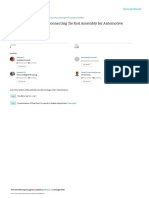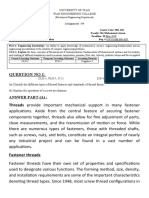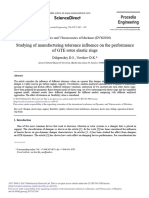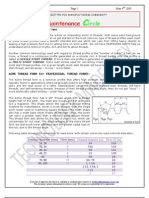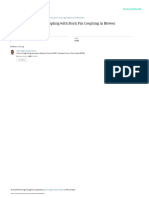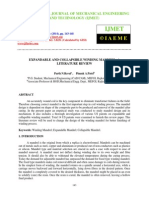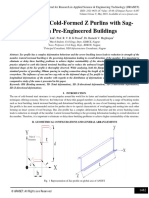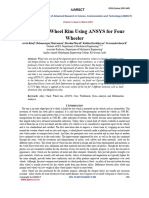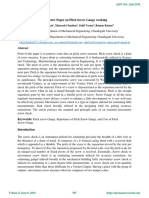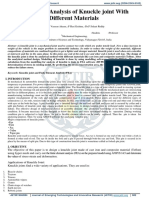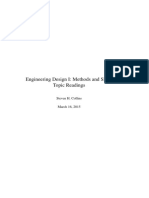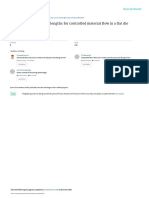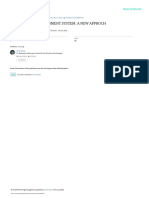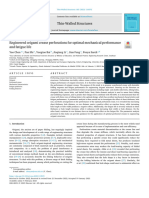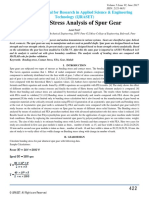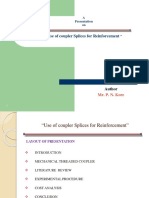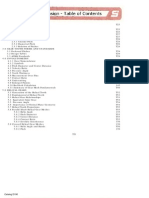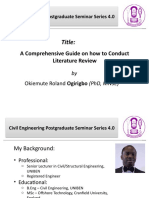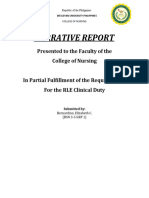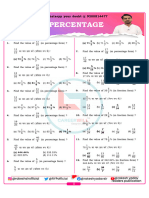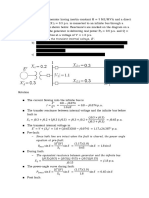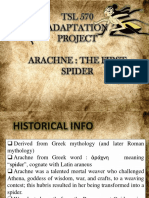Design Optimization of Stabilizer Bar Link Used in Sedan Vehicles
Design Optimization of Stabilizer Bar Link Used in Sedan Vehicles
Uploaded by
Ovidiu CostacheCopyright:
Available Formats
Design Optimization of Stabilizer Bar Link Used in Sedan Vehicles
Design Optimization of Stabilizer Bar Link Used in Sedan Vehicles
Uploaded by
Ovidiu CostacheOriginal Title
Copyright
Available Formats
Share this document
Did you find this document useful?
Is this content inappropriate?
Copyright:
Available Formats
Design Optimization of Stabilizer Bar Link Used in Sedan Vehicles
Design Optimization of Stabilizer Bar Link Used in Sedan Vehicles
Uploaded by
Ovidiu CostacheCopyright:
Available Formats
ISSN(Online): 2319-8753
ISSN (Print): 2347-6710
International Journal of Innovative Research in Science,
Engineering and Technology
(A High Impact Factor, Monthly, Peer Reviewed Journal)
Visit: www.ijirset.com
Vol. 8, Issue 5, May 2019
Design Optimization of Stabilizer Bar Link
Used In Sedan Vehicles
Farhan E M1, Dr.S.Sankar2, Tedy Thomas3 , Deepak.V.K4
PG Student, Dept. of Mechanical Engineering, Nehru College Of Engineering and Research Centre, Thrissur,
Kerala,India1
HOD, Dept. of Mechanical Engineering, Nehru college of engineering and Research Centre,Thrissur,Kerala,India 2
Assistant Professor, Dept. of Mechanical Engineering, Nehru college of engineering and Research Centre, Thrissur,
Kerala, India3
Assistant Professor, Dept. of Mechanical Engineering, Nehru college of engineering and Research Centre, Thrissur,
Kerala, India4
ABSTRACT: Suspension is the system of tyres, springs, shock absorbers and linkages that connects a vehicle to its
wheels and allows relative motion between the two. Suspension systems must support road holding, handling and ride
quality, which are at odds with each other. Normally the ball joints on stabilizer bar link at either end deteriorate and
develop lost movement which can be heard as a rattling or knocking noise. If this is ignored and the link rod actually
breaks, the anti-roll bar becomes completely ineffective. In this project, an existing model of stabilizer bar link is
designed in SolidWorks 2016 Edition, and analyzed the same in Ansys15.0.Then two modified designs are modeled
with change in shape of the link rod and introduction of spring in ball joint housing.Modified designs are analysed and
compared with the existing design.Three different materials such as Stainless steel, Titanium alloy and Grey cast iron
has been analysed in order to find out the best suitable material for the stabilizer bar link.A suspension system is also
designed according to the specification of an common sedan car,where the existing and modified stabilizer bar link is
installed to and analysed.Static structural and modal analysis are done on the designed models and results are
compared. From the results it can be concluded that spring introduced stabilizer bar link applied with stainless steel is
the best choice for application in the ssuspension system of sedan vehicles.
KEYWORDS: Stabilizer bar link,Sway bar link, Balljoint,Titaniumalloy,Stainlesssteel,Grey cast iron
I. INTRODUCTION
A sway or stabilizer bar prevents the car body from leaning too much and keeps the vehicle stable when driving in
turns. Most of the cars have one sway bar in the front and another separate sway bar in the rear suspension. Some cars
have only one sway bar in the front suspension. Sports cars have thicker sway bars for better stability when cornering.A
sway bar is connected via rubber bushings to the car body or frame in the middle. Outer ends of the sway bar are
connected to the parts of the vehicle suspension that holds the wheel (struts or control arms). The part that connects the
outer ends of the sway bar to the suspension component is called a sway bar link. In most cars a sway bar link has two
small ball joints at each end.Over time, the sway bar link ball joints wear out. The first sign of a worn-out sway bar link
is a knocking noise from the suspension when driving slow over road bumps. In rare cases, if the grease inside the sway
bar link joints dries up, it may also make a creaking noise when the suspension is moving up and down. Your mechanic
can check the sway bar links while performing a regular service with the car on the lift. A worn-out sway bar link will
show a free play when pushed up or down. An extremely worn out sway bar link can separate. This will cause your car
Copyright to IJIRSET DOI:10.15680/IJIRSET.2019.0805085 5597
ISSN(Online): 2319-8753
ISSN (Print): 2347-6710
International Journal of Innovative Research in Science,
Engineering and Technology
(A High Impact Factor, Monthly, Peer Reviewed Journal)
Visit: www.ijirset.com
Vol. 8, Issue 5, May 2019
to lean excessively in turns and feel less stable and secure on the road. A worn-out sway bar link must be replaced to
keep your vehicle safe.
II. DESIGN PROCEDURE
This section deals with the process of modeling. Model is a representation of an object, a system, or an idea in some
form other than that of the entity itself. Modeling is the process of producing a model; a model is a representation of the
construction and working of some system of interest. A model is similar to but simpler than the system it represents.
Generally, a model intended for a simulation study is a mathematical model developed with the help of simulation
software. Softwares commonly used for modelling are SolidWorks, Creo, Catia, Unigraphics etc. In this project
SolidWorks 2016 edition is used for the modelling process.
Design of stabilizer bar link
Table 1 Dimensions of stabilizer bar link with spring
S.no Description Dimensions(mm)
1 Length of the rod 230
2 Radius of the ball 8
bearing
3 Radius of the flange 7
4 Length of the screw 21
5 Radius of the screw 4.25
6 Angle of the bend 200
7 Length of the spring 5
Fig.1 Stabilizer bar link with spring 8 Radius of the bush 9.38
Design of suspension system Table 2 Dimensions of suspension system
S.no Description Dimensions(mm)
1 Length of the spring 254
2 Radius of the spring 5
wire
3 Total length of system 479
4 Radius of the flange 69
5 Thickness of the flange 2
Fig.2 Suspension system
Copyright to IJIRSET DOI:10.15680/IJIRSET.2019.0805085 5598
ISSN(Online): 2319-8753
ISSN (Print): 2347-6710
International Journal of Innovative Research in Science,
Engineering and Technology
(A High Impact Factor, Monthly, Peer Reviewed Journal)
Visit: www.ijirset.com
Vol. 8, Issue 5, May 2019
III. ANSYS PROCEDURE
This section deals with the analysis of the designed model. The model that is in STEP format is analysed. Static
structural analysis of both stabilizer bar link and suspension system is performed by applying the working load and
number of supports used is two. The model is imported to Ansys and meshing is performed. The mesh size used is 4.4
mm. From the results obtained optimal design is selected. Suitable materials are applied to three different models of
stabilizer bar link and modal analysis is performed. Different softwares such as Comsol, Radioss solver, Abaqus,
Hypermesh, Ansys etc. are used for analysis. In this project Ansys R15.0 is used for design analysis.
Design analysis
The figure shown below represents the meshed image of total suspension system and the force application in the
stabilizer bar link
Fig.3 Meshed image of total suspension system Fig.4 Force application in stabilizer bar link
The figure shown below represents the total deformation in the stabilizer bar link with spring
Table 3 Overview of analysis results
Total
Stabilizer bar
Sl.No deformation(mm)
link
Max
1 Ordinary 12.388
With change in
2 8.3413
shape
3 Spring 5.0527
Fig.5.Total deformation of stabilizer bar link with spring
Copyright to IJIRSET DOI:10.15680/IJIRSET.2019.0805085 5599
ISSN(Online): 2319-8753
ISSN (Print): 2347-6710
International Journal of Innovative Research in Science,
Engineering and Technology
(A High Impact Factor, Monthly, Peer Reviewed Journal)
Visit: www.ijirset.com
Vol. 8, Issue 5, May 2019
From the analysis results it can be concluded that the stabilizer with introduction of spring have the least value of
maximum total deformation. Hence stabilizer bar link with spring is selected for further analyses.The figure shown
below represents the total deformation of suspension system with spring introduced stabilizer bar link
Table 4 Overview of analysis results
Total
Suspension
Sl.No deformation(mm)
system
Max
With ordinary
1 1.3146
stabilizer bar link
With shape
2 changed stabilizer 1.1602
bar link
With spring
3 introduced 0.62821
Fig.6 Total deformation of suspension system
stabilizer bar link
with spring introduced stabilizer bar link
From the analysis results it can be concluded that the suspension system with spring introduced stabilizer bar link have
the least value of maximum total deformation. Hence suspension system with spring introduced stabilizer bar link is
selected as the best suitable system.
IV. MATERIAL OPTIMISATION
Table 5 Overview of analysis results of the stabilizer bar link using three different materials
Stainle Titaniu Grey cast
Design parameter
ss steel m Alloy iron
Total Max 3.897 5.7353 5.0527
deformation
(mm) Min 0 0 0
Max 3.5731 5.1838 4.5908
Directional
deformation -
-
(mm) Min 0.0316 -0.020947
0.02174
93
Max 309.75 589.98 541.49
Equivalent
stress (MPa) 0.0025 0.00477
Min 0.0040365
005 71
0.0016 0.00489
Max 0.0043833
Equivalent 135 22
elastic strain 3.1246 6.8763e
Min 5.7885e-8
e-8 -8
Copyright to IJIRSET DOI:10.15680/IJIRSET.2019.0805085 5600
ISSN(Online): 2319-8753
ISSN (Print): 2347-6710
International Journal of Innovative Research in Science,
Engineering and Technology
(A High Impact Factor, Monthly, Peer Reviewed Journal)
Visit: www.ijirset.com
Vol. 8, Issue 5, May 2019
The above shown table represents analysis results of the stabilizer bar link using three different materials.Three
different materials are applied to the stabilizer bar link with spring and the analysis results are compared to select the
most suitablematerial. The three different materials used for analyses are Stainless Steel, Titanium Alloy, Grey Cast
Iron.
V. MODAL ANALYSIS
Table 6 Comparison of the natural frequencies of the Table 7 Comparison of the natural frequencies of
three different models of stabilizer bar link stabilizer bar link applied with different materials
Change Grey
With Sl.No Mode Stainless Titanium Cast
Sl.No Mode Ordinary in
spring Steel Alloy Iron
shape
1 1 1 34.515 32.236 30.066
1 22.082 25.32 30.066
2 2 2 2 34.69 34.225 31.487
24.047 25.681 31.487
3 3 3 3 278.97 271.26 240.77
247.3 250.93 240.77
4 4 4 4 280.74 275.04 241.26
253.13 256.91 241.26
5 5 5 5 423.55 363.62 350.93
344.15 311.87 350.93
6 6 6 6 526.27 575.4 508.87
466.47 460.54 508.87
By comparing the results of modal analysis listed in the Table 6 and 7,it can be clearly understood that the spring
introduced stabilizer bar link applied with stainless steel is the best suitable for the suspension system.
VI. RESULT AND DISCUSSION
Fig. 7 Total deformation of three different models of stabilizer bar link
Copyright to IJIRSET DOI:10.15680/IJIRSET.2019.0805085 5601
ISSN(Online): 2319-8753
ISSN (Print): 2347-6710
International Journal of Innovative Research in Science,
Engineering and Technology
(A High Impact Factor, Monthly, Peer Reviewed Journal)
Visit: www.ijirset.com
Vol. 8, Issue 5, May 2019
From the above graph,we can see that the total deformation has reduced by 32.67% when the shape of the stabilizer bar
link was changed compared to the ordinary shape.We can also see that the total deformation has reduced by 59.21%
when a spring is introduced in the ball bearing housing compared to the ordinary one.
6 5.7353
5.0527
5
3.897
4 STAINLESS STEEL
3
TITANIUM ALLOY
2
GREY CAST IRON
1
0
Max
Total deformation (mm)
Fig 8 Comparison of spring introduced stabilizer bar link applied with three different materials.
From the above graph,we can see that the total deformation of the stabilizer bar linkhas reduced by 11.90% when it is
applied with Grey cast iron compared to Titanium alloy.We can also see that the total deformation has reduced by
32.05% when it is applied with Stainless steel compared to Titanium alloy.
VII CONCLUSION
In this project three different models of stabilizer bar link were designed using SolidWorks 2016 edition and the
designed model was analysed using ANSYS R15.0. From the analysis results it was found out that stabilizer bar link
with spring introduced in the ball bearing housing has minimum total deformation. Then a suspension system was
designed according to the specification of a common sedan vehicle and was subjected to a force of 500N and it is here
where the stabilizer bar link acts. After analysis it is found that the suspension system with spring introduced stabilizer
bar link has the least total deformation. From the three different materials such as Stainless Steel, Titanium alloy and
Grey cast iron applied, analysis results shows that the stabilizer bar link applied with Stainless steel provides least total
deformation. Results on modal analysis show that stabilizer bar link with spring exhibits higher natural frequency.
Modal analysis on spring introduced stabilizer bar link with three different materials such as Stainless steel, titanium
alloy and Grey cast iron also proves that Stainless steel have higher natural frequency. From above results we can
conclude that spring introduced stabilizer bar link applied with Stainless steel proves to be the best choice for improved
performance in sedan vehicles.
Copyright to IJIRSET DOI:10.15680/IJIRSET.2019.0805085 5602
ISSN(Online): 2319-8753
ISSN (Print): 2347-6710
International Journal of Innovative Research in Science,
Engineering and Technology
(A High Impact Factor, Monthly, Peer Reviewed Journal)
Visit: www.ijirset.com
Vol. 8, Issue 5, May 2019
REFERENCES
[1] E.A. Ossa, C.C. Palacio, M.A. Paniagua,Failure analysis of a car suspension system ball joint, Materials
Engineering Research Group, Eafit University, Cra. 49 No. 7 sur 50, Medellin, Colombia
[2] AnshulDhakar and RishavRanjan, Force calculation in upright of a formula sae race car, Department of
Mechanical Engineering, RV College of Engineering,
[3] SadjyotBiswal,AravindPrasanth, Dr. R Udayakumar, Shobhit Deva, AmanGupta,Design of a suspension system
and determining suspension parametersof a medium downforce small Formula type car.Automotive, Mechanical
Department, BITS Pilani Dubai Campus, DIAC, 345055
[4] C. Kavitha , S. Abinav Shankar , B. Ashok Adaptive Suspension Strategy For A Double Wishbone Suspension
Through Camber And Toe Optimization .A. Criminisi, P. Perez, and K. Toyama, “Region filling and object
removal by exemplar-based image inpainting.”, IEEE Transactions on Image Processing, vol. 13, no.9, pp. 1200–
1212, 2004.
[5] PetreAlexandru, Ion Visa, CatalinAlexandru 3modeling The Angular Capability Of The Ball Joints In A Complex
Mechanism With Two Degrees Of Mobility .Yassin M. Y. Hasan and Lina J. Karam, “Morphological Text
Extraction from Images”,IEEE Transactions On Image Processing, vol. 9, No. 11, 2000
Copyright to IJIRSET DOI:10.15680/IJIRSET.2019.0805085 5603
You might also like
- Design Calculations For Snap Fit Joints in Plastic Parts Ticona PDFDocument30 pagesDesign Calculations For Snap Fit Joints in Plastic Parts Ticona PDFSuteu Ionel100% (1)
- Wilderness Cluster Course 1Document47 pagesWilderness Cluster Course 1api-421743003No ratings yet
- Performance Exhaust Systems: How to Design, Fabricate, and Install: How to Design, Fabricate, and InstallFrom EverandPerformance Exhaust Systems: How to Design, Fabricate, and Install: How to Design, Fabricate, and InstallRating: 4 out of 5 stars4/5 (8)
- Report Roller ChainDocument11 pagesReport Roller ChainPejuangHati100% (1)
- Fundamentals of Physics, 8th Edition Halliday, Resnick, WalkerDocument5 pagesFundamentals of Physics, 8th Edition Halliday, Resnick, Walkerabhishekkumar1996No ratings yet
- Blade ArrangmentsDocument6 pagesBlade ArrangmentsRavi MirzaNo ratings yet
- Design and Analysis of Connecting Tie Rod Assembly For Automotive ApplicationDocument7 pagesDesign and Analysis of Connecting Tie Rod Assembly For Automotive ApplicationvipimNo ratings yet
- Natrayan 2018Document7 pagesNatrayan 2018Agastin RubanNo ratings yet
- Design & Analysis of Improvised Clutch Pedal Linkage Mechanism Using Catia V5Document8 pagesDesign & Analysis of Improvised Clutch Pedal Linkage Mechanism Using Catia V5TJPRC PublicationsNo ratings yet
- ShaikJohnBhasha HariSankarVanka 50Document7 pagesShaikJohnBhasha HariSankarVanka 50Vignesan MechNo ratings yet
- Screw Thread ReportDocument17 pagesScrew Thread Reportkittikhun_simlee100% (1)
- Sprocket Guide123456789Document17 pagesSprocket Guide123456789Ramsai ChigurupatiNo ratings yet
- B. PavananDocument5 pagesB. Pavanannideshsivaneh893No ratings yet
- FEA of Tie Rod of Steering System of CarDocument6 pagesFEA of Tie Rod of Steering System of CarpranavNo ratings yet
- Cotter Joint CoferenceDocument5 pagesCotter Joint CoferenceMuhammad AliNo ratings yet
- 8.6 Measurement of Screw Threads: Engineering Metrology and MeasurementsDocument8 pages8.6 Measurement of Screw Threads: Engineering Metrology and MeasurementsAliaa NasserNo ratings yet
- Question No 1:: Answer Part (A)Document6 pagesQuestion No 1:: Answer Part (A)Saad khanNo ratings yet
- Roller Chain GuideDocument5 pagesRoller Chain GuidechikoopandaNo ratings yet
- 1 s2.0 S1877705817308640 MainDocument15 pages1 s2.0 S1877705817308640 MainwondreamckNo ratings yet
- Threads Part TwoDocument10 pagesThreads Part TwoMaintenance CircleNo ratings yet
- 125 30 ReplacementDocument8 pages125 30 Replacementdipu2381995No ratings yet
- 821.study of EffeDocument6 pages821.study of EffeVashishth KushwahaNo ratings yet
- 187 MR160703 Shrikant Paper V1Document11 pages187 MR160703 Shrikant Paper V1khai6367No ratings yet
- Failure Analysis of Primary Suspension Spring of Rail Road VehicleDocument15 pagesFailure Analysis of Primary Suspension Spring of Rail Road Vehicle012 ANMOL RATANNo ratings yet
- 125 30 Replacement PDFDocument7 pages125 30 Replacement PDF黃冠旗No ratings yet
- Ijmet: ©iaemeDocument6 pagesIjmet: ©iaemeIAEME PublicationNo ratings yet
- High-Precision Thread Couplers Mitro Industries - Rebar Coupler SystemDocument10 pagesHigh-Precision Thread Couplers Mitro Industries - Rebar Coupler SystemMitro IndustriesNo ratings yet
- Behaviour of Cold-Formed Z Purlins With Sag-Rods in Pre-Engineered BuildingsDocument7 pagesBehaviour of Cold-Formed Z Purlins With Sag-Rods in Pre-Engineered BuildingsIJRASETPublicationsNo ratings yet
- Paper 904Document9 pagesPaper 904Mukunda DabairNo ratings yet
- Spur Gear MechanismDocument10 pagesSpur Gear MechanismPusapati Saketh Varma ed21b048No ratings yet
- Design Calculation For Snap Joints in Plastic Parts - ticoNADocument10 pagesDesign Calculation For Snap Joints in Plastic Parts - ticoNACarlos Aguilar RodríguezNo ratings yet
- A Review Paper On Pitch Screw Gauge Working: Vikas Chauhan, Muneesh Chauhan, Sahil Verma, Raman KumarDocument6 pagesA Review Paper On Pitch Screw Gauge Working: Vikas Chauhan, Muneesh Chauhan, Sahil Verma, Raman KumarMuskan MalikNo ratings yet
- JETIR1906R84Document10 pagesJETIR1906R84Vignesan MechNo ratings yet
- Mini Project Report - IV-A-Batch No-20Document40 pagesMini Project Report - IV-A-Batch No-20RITESH RATHORENo ratings yet
- Investigation On The Distortional Buckling Behaviour of Cold-Formed SupaCee Beam With Different Web Hole Shape and Crimped FlangesDocument10 pagesInvestigation On The Distortional Buckling Behaviour of Cold-Formed SupaCee Beam With Different Web Hole Shape and Crimped FlangesIJRASETPublicationsNo ratings yet
- MIsalignedshaftDocument7 pagesMIsalignedshaftBa1313yNo ratings yet
- Topic Reading 7 - Catalog ComponentsDocument28 pagesTopic Reading 7 - Catalog ComponentsDan StrutheNo ratings yet
- Design of Castelleated Beam by British CodeDocument8 pagesDesign of Castelleated Beam by British Codemsn sastryNo ratings yet
- Optimization of Bearing Lengths For Controlled Material Flow in A Flat Die Aluminium Extrusion - Viswanath AmmuDocument7 pagesOptimization of Bearing Lengths For Controlled Material Flow in A Flat Die Aluminium Extrusion - Viswanath AmmuNatural AlNo ratings yet
- Design, Analysis and Testing of Spindle For High Speed CNC Lathe MachineDocument8 pagesDesign, Analysis and Testing of Spindle For High Speed CNC Lathe MachineArif NurrohmanNo ratings yet
- Design and Fabrication of Toggle JackDocument30 pagesDesign and Fabrication of Toggle JackJitendra Rout0% (1)
- Low Cost Laser Alignment System: A New Approch: World Journal of Pharmacy and Pharmaceutical Sciences January 2016Document18 pagesLow Cost Laser Alignment System: A New Approch: World Journal of Pharmacy and Pharmaceutical Sciences January 2016AMARNATH PRASADNo ratings yet
- Thread DetailsDocument27 pagesThread DetailsN.PalaniappanNo ratings yet
- Ultrasonic Inspection of Welds in Tubes & Pipes: Educational NoteDocument13 pagesUltrasonic Inspection of Welds in Tubes & Pipes: Educational NoteleonciomavarezNo ratings yet
- Tie Rod Analysis Using FEA and Use of BDocument5 pagesTie Rod Analysis Using FEA and Use of BKarran KapurNo ratings yet
- G J E S R: Lobal Ournal of Ngineering Cience and EsearchesDocument5 pagesG J E S R: Lobal Ournal of Ngineering Cience and EsearchesSuriya RajendranNo ratings yet
- Filete ASMEDocument28 pagesFilete ASMEMarcel MaresNo ratings yet
- Jiang 2021 J. Phys. Conf. Ser. 1986 012097Document7 pagesJiang 2021 J. Phys. Conf. Ser. 1986 012097dawit gashuNo ratings yet
- Craby Steering SystemDocument13 pagesCraby Steering SystemIJRASETPublicationsNo ratings yet
- Analysis of Knuckle JointDocument12 pagesAnalysis of Knuckle JointSUNIL AHERNo ratings yet
- Engineering_Origami_crease_perforations_Thinwalled_2023Document9 pagesEngineering_Origami_crease_perforations_Thinwalled_2023Vijayan SuryakantNo ratings yet
- Ijiset V2 I1 12Document8 pagesIjiset V2 I1 12Cesar Manuel Diaz QuinteroNo ratings yet
- Bending Stress Analysis of Spur GearDocument5 pagesBending Stress Analysis of Spur GearharshaNo ratings yet
- Design and Optimization Formula SAE DrivetrainDocument21 pagesDesign and Optimization Formula SAE DrivetrainIJRASETPublicationsNo ratings yet
- Presentation Coupler SystemDocument21 pagesPresentation Coupler SystemPralhad Kore100% (1)
- Fault Diagnosis of Two Rotor SystemDocument12 pagesFault Diagnosis of Two Rotor SystemIJRASETPublicationsNo ratings yet
- A Literature Review and Study On Design, Fabrication and Analysis of Tie Rods For Steering MechanismDocument7 pagesA Literature Review and Study On Design, Fabrication and Analysis of Tie Rods For Steering MechanismIJRASETPublicationsNo ratings yet
- Gear DesignDocument156 pagesGear DesignGiang T Le100% (4)
- Published PaperDocument15 pagesPublished PapersawravkblNo ratings yet
- Design and Analysis of Leaf Spring Using AnsysDocument8 pagesDesign and Analysis of Leaf Spring Using AnsysIJRASETPublicationsNo ratings yet
- Modelling of Vibrations of Overhead Line Conductors: Assessment of the TechnologyFrom EverandModelling of Vibrations of Overhead Line Conductors: Assessment of the TechnologyGiorgio DianaNo ratings yet
- 1988 - Sachdeva - Two-Phase Flow Through Electric Submersible PumpsDocument279 pages1988 - Sachdeva - Two-Phase Flow Through Electric Submersible PumpsCesar AlataNo ratings yet
- Title:: A Comprehensive Guide On How To Conduct Literature ReviewDocument19 pagesTitle:: A Comprehensive Guide On How To Conduct Literature ReviewOkiemute Roland OgirigboNo ratings yet
- 80486Document34 pages80486yuvarajNo ratings yet
- Module IV - TRANSPORTATION SECTORDocument17 pagesModule IV - TRANSPORTATION SECTORSHERWIN GONZALESNo ratings yet
- Narrative ReportDocument9 pagesNarrative ReportKiko BernardinoNo ratings yet
- Percentage Practice Sheet - 01Document3 pagesPercentage Practice Sheet - 01275 DILIP RAYGORNo ratings yet
- Chrome Release Cycle 12-16-2010Document21 pagesChrome Release Cycle 12-16-2010TechCrunch100% (1)
- Emperor JonesDocument18 pagesEmperor JonesBurcu KılınçNo ratings yet
- Education Schemes Sindh Government 2022-2023Document110 pagesEducation Schemes Sindh Government 2022-2023Aijaz ZaiNo ratings yet
- WWW - Fiac.it - All Rights ReservedDocument2 pagesWWW - Fiac.it - All Rights ReservedCECOEL GROUPNo ratings yet
- Ebook Fce Writing 4schoolsDocument26 pagesEbook Fce Writing 4schoolsmorag robertsNo ratings yet
- Quiz #6Document7 pagesQuiz #6Michael MerlinNo ratings yet
- China Energy Security The Malacca Dilemma and ResponsesDocument4 pagesChina Energy Security The Malacca Dilemma and ResponsesNguyễn Ngọc Bảo TrânNo ratings yet
- Since Both Line Are Intact When The Fault Is Cleared, The Power Angle Equation at Pre-FaultDocument2 pagesSince Both Line Are Intact When The Fault Is Cleared, The Power Angle Equation at Pre-Faultsebinjosephsabi8914No ratings yet
- ARH 304 Group 4 BONTOC HOUSE Philippine Vernacular ArchitectureDocument11 pagesARH 304 Group 4 BONTOC HOUSE Philippine Vernacular ArchitectureSarah Grace BelañoNo ratings yet
- TSL 570 Adaptation Project - Arachne: The First SpiderDocument21 pagesTSL 570 Adaptation Project - Arachne: The First SpidernajihahyusofNo ratings yet
- BNP Paribas Uk-Student-Housing-Market-Update - Compressed-1Document2 pagesBNP Paribas Uk-Student-Housing-Market-Update - Compressed-1hamza3iqbalNo ratings yet
- International RA472 Front Rear Axle Parts ManualDocument5 pagesInternational RA472 Front Rear Axle Parts ManualHéctor Perez SNo ratings yet
- People v. Dacudao, 170 SCRA 489Document4 pagesPeople v. Dacudao, 170 SCRA 489JNo ratings yet
- The Whispering WoodsDocument2 pagesThe Whispering WoodsFlaviio FreteNo ratings yet
- Team Building For Youth Organization: CWTS - Civic Welfare Training Service Units: 3.0Document4 pagesTeam Building For Youth Organization: CWTS - Civic Welfare Training Service Units: 3.0Jon Aragasi100% (1)
- Seismic Base IsolationDocument23 pagesSeismic Base IsolationMia Hussain100% (3)
- Biology 2201 - Respiratory System Notes PDFDocument11 pagesBiology 2201 - Respiratory System Notes PDFVishal SharmaNo ratings yet
- DCM Series Brushed Servo Motors: Electrical SpecificationsDocument3 pagesDCM Series Brushed Servo Motors: Electrical SpecificationsNguyen Van ThaiNo ratings yet
- HIPAADocument3 pagesHIPAAGrace CotesNo ratings yet
- 02 & 12 - Anup & Hitesh - Jubilant FoodWorks LTDDocument10 pages02 & 12 - Anup & Hitesh - Jubilant FoodWorks LTDasitbhatiaNo ratings yet
- Fitbit Versa 3 User ManualDocument92 pagesFitbit Versa 3 User Manualp-j-wNo ratings yet
- Nikon 50mm F - 1Document49 pagesNikon 50mm F - 1Abar ZuhaitzNo ratings yet






